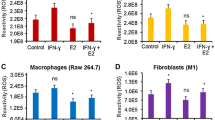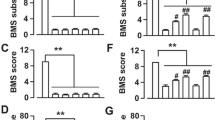Abstract
Spinal cord injury (SCI), depending on the severity of injury, leads to neurological dysfunction and paralysis. Methylprednisolone, the only currently available therapy renders limited protection in SCI. Therefore, other therapeutic agents must be tested to maximize neuroprotection and functional recovery. Previous data from our laboratory indicate that estrogen (17β-estradiol) at a high dose may attenuate multiple damaging pathways involved in SCI and improve locomotor outcome. Since use of high dose estrogen may have detrimental side effects and therefore may never be used in the clinic, the current study investigated the efficacy of this steroid hormone at very low doses in SCI. In particular, we tested the impact of dosing (1–10 μg/kg), mode of delivery (intravenous vs. osmotic pump), and delay in estrogen application (15 min–4 h post-SCI) on microgliosis and neuronal death in acute SCI in rats. Treatment with 17β-estradiol (1–10 μg/kg) significantly reduced microglial activation and also attenuated apoptosis of neurons compared to untreated SCI animals. The attenuation of cell death and inflammation by estrogen was observed regardless of mode and time of delivery following injury. These findings suggest estrogen as a potential agent for the treatment of individuals with SCI.



Similar content being viewed by others
References
Dumont RJ, Verma S, Okonkwo DO et al (2001) Acute spinal cord injury, part II: contemporary pharmacotherapy. Clin Neuropharmacol 24(5):265–279
Peter Vellman W, Hawkes AP, Lammertse DP (2003) Administration of corticosteroids for acute spinal cord injury: the current practice of trauma medical directors and emergency medical system physician advisors. Spine (Phila Pa 1976) 28(9):941–947: discussion 947
Bracken MB, Collins WF, Freeman DF et al (1984) Efficacy of methylprednisolone in acute spinal cord injury. JAMA 251(1):45–52
Hurlbert RJ (2000) Methylprednisolone for acute spinal cord injury: an inappropriate standard of care. J Neurosurg 93(1 Suppl):1–7
Liu D, Liu J, Wen J (1999) Elevation of hydrogen peroxide after spinal cord injury detected by using the Fenton reaction. Free Radic Biol Med 27(3–4):478–482
Sakurai M, Nagata T, Abe K et al (2003) Survival and death-promoting events after transient spinal cord ischemia in rabbits: induction of Akt and caspase3 in motor neurons. J Thorac Cardiovasc Surg 125(2):370–377
Young W (1985) The role of calcium in spinal cord injury. Cent Nerv Syst Trauma 2(2):109–114
Happel RD, Smith KP, Banik NL et al (1981) Ca2+-accumulation in experimental spinal cord trauma. Brain Res 211(2):476–479
Stokes BT, Fox P, Hollinden G (1983) Extracellular calcium activity in the injured spinal cord. Exp Neurol 80(3):561–572
Ray SK, Matzelle DD, Wilford GG et al (2000) Increased calpain expression is associated with apoptosis in rat spinal cord injury: calpain inhibitor provides neuroprotection. Neurochem Res 25(9–10):1191–1198
Springer JE, Azbill RD, Kennedy SE et al (1997) Rapid calpain I activation and cytoskeletal protein degradation following traumatic spinal cord injury: attenuation with riluzole pretreatment. J Neurochem 69(4):1592–1600
Lewen A, Matz P, Chan PH (2000) Free radical pathways in CNS injury. J Neurotrauma 17(10):871–890
Michaelis EK (1998) Molecular biology of glutamate receptors in the central nervous system and their role in excitotoxicity, oxidative stress and aging. Prog Neurobiol 54(4):369–415
Mills CD, Xu GY, Johnson KM et al (2000) AIDA reduces glutamate release and attenuates mechanical allodynia after spinal cord injury. Neuroreport 11(14):3067–3070
Carlson SL, Parrish ME, Springer JE et al (1998) Acute inflammatory response in spinal cord following impact injury. Exp Neurol 151(1):77–88
Sharma HS, Olsson Y, Nyberg F et al (1993) Prostaglandins modulate alterations of microvascular permeability, blood flow, edema and serotonin levels following spinal cord injury: an experimental study in the rat. Neuroscience 57(2):443–449
Barut S, Canbolat A, Bilge T et al (1993) Lipid peroxidation in experimental spinal cord injury: time-level relationship. Neurosurg Rev 16(1):53–59
Wingrave JM, Schaecher KE, Sribnick EA et al (2003) Early induction of secondary injury factors causing activation of calpain and mitochondria-mediated neuronal apoptosis following spinal cord injury in rats. J Neurosci Res 73(1):95–104
Agrawal SK, Nashmi R, Fehlings MG (2000) Role of L- and N-type calcium channels in the pathophysiology of traumatic spinal cord white matter injury. Neuroscience 99(1):179–188
Li S, Jiang Q, Stys PK (2000) Important role of reverse Na(+)–Ca(2+) exchange in spinal cord white matter injury at physiological temperature. J Neurophysiol 84(2):1116–1119
Sribnick EA, Matzelle DD, Banik NL et al (2007) Direct evidence for calpain involvement in apoptotic death of neurons in spinal cord injury in rats and neuroprotection with calpain inhibitor. Neurochem Res 32(12):2210–2216
Ray SK, Banik NL (2003) Calpain and its involvement in the pathophysiology of CNS injuries and diseases: therapeutic potential of calpain inhibitors for prevention of neurodegeneration. Curr Drug Targets CNS Neurol Disord 2(3):173–189
Pike BR, Zhao X, Newcomb JK et al (1998) Regional calpain and caspase-3 proteolysis of alpha-spectrin after traumatic brain injury. Neuroreport 9(11):2437–2442
Banik NL, Chou CH, Deibler GE et al (1994) Peptide bond specificity of calpain: proteolysis of human myelin basic protein. J Neurosci Res 37(4):489–496
Gao G, Dou QP (2000) N-terminal cleavage of bax by calpain generates a potent proapoptotic 18-kDa fragment that promotes bcl-2-independent cytochrome C release and apoptotic cell death. J Cell Biochem 80(1):53–72
Blomgren K, Zhu C, Wang X et al (2001) Synergistic activation of caspase-3 by m-calpain after neonatal hypoxia-ischemia: a mechanism of “pathological apoptosis”? J Biol Chem 276(13):10191–10198
Pang Z, Bondada V, Sengoku T et al (2003) Calpain facilitates the neuron death induced by 3-nitropropionic acid and contributes to the necrotic morphology. J Neuropathol Exp Neurol 62(6):633–643
Nath R, Raser KJ, Stafford D et al (1996) Non-erythroid alpha-spectrin breakdown by calpain and interleukin 1 beta-converting-enzyme-like protease(s) in apoptotic cells: contributory roles of both protease families in neuronal apoptosis. Biochem J 319(Pt 3):683–690
Sribnick EA, Wingrave JM, Matzelle DD et al (2003) Estrogen as a neuroprotective agent in the treatment of spinal cord injury. Ann N Y Acad Sci 993:125–133: discussion 159–160
Sribnick EA, Ray SK, Banik NL (2004) Estrogen as a multi-active neuroprotective agent in traumatic injuries. Neurochem Res 29(11):2007–2014
Samantaray S, Sribnick EA, Das A et al (2010) Neuroprotective efficacy of estrogen in experimental spinal cord injury in rats. Ann NY Acad Sci 1199:90–94
Moosmann B, Behl C (1999) The antioxidant neuroprotective effects of estrogens and phenolic compounds are independent from their estrogenic properties. Proc Natl Acad Sci USA 96(16):8867–8872
Dimayuga FO, Reed JL, Carnero GA et al (2005) Estrogen and brain inflammation: effects on microglial expression of MHC, costimulatory molecules and cytokines. J Neuroimmunol 161(1–2):123–136
Sribnick EA, Del Re AM, Ray SK et al (2009) Estrogen attenuates glutamate-induced cell death by inhibiting Ca2+ influx through L-type voltage-gated Ca2+ channels. Brain Res 1276:159–170
Sribnick EA, Ray SK, Nowak MW et al (2004) 17beta-estradiol attenuates glutamate-induced apoptosis and preserves electrophysiologic function in primary cortical neurons. J Neurosci Res 76(5):688–696
Sribnick EA, Samantaray S, Das A et al (2010) Postinjury estrogen treatment of chronic spinal cord injury improves locomotor function in rats. J Neurosci Res 88(8):1738–1750
Sribnick EA, Matzelle DD, Ray SK et al (2006) Estrogen treatment of spinal cord injury attenuates calpain activation and apoptosis. J Neurosci Res 84(5):1064–1075
Kwon BK, Okon E, Hillyer J et al. (2011, in press) A systematic review of non-invasive pharmacologic neuroprotective treatments for acute spinal cord injury. J Neurotrauma
Swartz KR, Fee DB, Joy KM et al (2007) Gender differences in spinal cord injury are not estrogen-dependent. J Neurotrauma 24(3):473–480
Perot PL Jr, Lee WA, Hsu CY et al (1987) Therapeutic model for experimental spinal cord injury in the rat: I. Mortality and motor deficit. Cent Nerv Syst Trauma 4(3):149–159
Samantaray S, Sribnick EA, Das A et al (2008) Melatonin attenuates calpain upregulation, axonal damage and neuronal death in spinal cord injury in rats. J Pineal Res 44(4):348–357
Ray SK, Schaecher KE, Shields DC et al (2000) Combined TUNEL and double immunofluorescent labeling for detection of apoptotic mononuclear phagocytes in autoimmune demyelinating disease. Brain Res Brain Res Protoc 5(3):305–311
Samantaray S, Matzelle DD, Ray SK et al (2010) Physiological low dose of estrogen-protected neurons in experimental spinal cord injury. Ann NY Acad Sci 1199:86–89
Brown CM, Suzuki S, Jelks KA et al (2009) Estradiol is a potent protective, restorative, and trophic factor after brain injury. Semin Reprod Med 27(3):240–249
Suzuki S, Brown CM, Wise PM (2009) Neuroprotective effects of estrogens following ischemic stroke. Front Neuroendocrinol 30(2):201–211
Bourque M, Dluzen DE, Di Paolo T (2009) Neuroprotective actions of sex steroids in Parkinson’s disease. Front Neuroendocrinol 30(2):142–157
Sribnick EA, Wingrave JM, Matzelle DD et al (2005) Estrogen attenuated markers of inflammation and decreased lesion volume in acute spinal cord injury in rats. J Neurosci Res 82(2):283–293
Yune TY, Kim SJ, Lee SM et al (2004) Systemic administration of 17beta-estradiol reduces apoptotic cell death and improves functional recovery following traumatic spinal cord injury in rats. J Neurotrauma 21(3):293–306
Chaovipoch P, Jelks KA, Gerhold LM et al (2006) 17beta-estradiol is protective in spinal cord injury in post- and pre-menopausal rats. J Neurotrauma 23(6):830–852
Ritz MF, Hausmann ON (2008) Effect of 17beta-estradiol on functional outcome, release of cytokines, astrocyte reactivity and inflammatory spreading after spinal cord injury in male rats. Brain Res 1203:177–188
Rahimi-Movaghar V, Saadat S, Vaccaro AR et al (2009) The efficacy of surgical decompression before 24 hours versus 24–72 hours in patients with spinal cord injury from T1 to L1–with specific consideration on ethics: a randomized controlled trial. Trials 10:77
Quinn R (2005) Comparing rat’s to human’s age: how old is my rat in people years? Nutrition 21(6):775–777
Acknowledgments
Completion of this project was made possible by funding from the National Institutes of Health (NIH) and National Institute of Neurological Disorders and Stroke (NINDS): (NS-31622, NS-38146, and NS-41088) and the State of South Carolina Spinal Cord Injury Research Fund (SCSCIRF).
Author information
Authors and Affiliations
Corresponding author
Rights and permissions
About this article
Cite this article
Samantaray, S., Smith, J.A., Das, A. et al. Low dose Estrogen Prevents Neuronal Degeneration and Microglial Reactivity in an Acute Model of Spinal Cord Injury: Effect of Dosing, Route of Administration, and Therapy Delay. Neurochem Res 36, 1809–1816 (2011). https://doi.org/10.1007/s11064-011-0498-y
Accepted:
Published:
Issue Date:
DOI: https://doi.org/10.1007/s11064-011-0498-y




